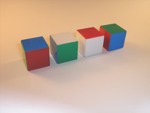 Back in 1967, puzzlemaker Frank Armbruster released a devious puzzle through Parker Brothers that took the world by storm.
Back in 1967, puzzlemaker Frank Armbruster released a devious puzzle through Parker Brothers that took the world by storm.
It was called Instant Insanity, and has sold over 12 million copies (and, like Rubik's Cube, spawned numerous imitations). Parker Brothers re-released it in the 1980s, while the world was going nuts over Rubik's Cube. Here's the 1980s ad for Instant Insanity:
So, what exactly was the challenge? The puzzle itself came as 4 separate cubes, with each side of each cube being one 4 colors (green, red, blue, and yellow), and the colors were arranged on different cubes in different ways. The object of the puzzle is to stack these cubes in a column so that each side (front, back, left, and right) of the stack shows each of the four colors (as shown in the top left photo in this post).
At first, this doesn't sound that hard. As a matter of fact, you can try it out here on Grey Matters (Java required). Alternatively, here's a Javascript version.
In both of the above versions, the cubes are effectively unfolded and lay flat. If you prefer to work with a version where the subes remain in 3-D, there's the online nrich Instant Insanity version (Flash required), or the even more tactile iPad version.
By 1971, the puzzle was so popular and so recognizable, it was used as part of a computer vision project at the Stanford University Artificial Intelligence Laboratory, displayed to the public at an artificial intelligence conference:
How would a human go about solving it, though?
It's not easy. Perhaps you may get a clue from this video (you might want to turn down the volume before hitting play), if you watch carefully enough:
Hmmm...what are those lines and circles? Well, they look kind of like the ones Leonard Euler (pronounced "oiler") used to solve the classic Seven Bridges of Königsberg problem.
Basically, that's exactly what this is. Since the goal of Instant Insanity is to form a particular relationship among the sides, this boils down to a networking problem.
In Ivars Peterson's August 9, 1999 column, Averting Instant Insanity, he shows how to simplify the problem down with simple graphs representing the color arrangements, much like Euler did with the Seven Bridges of Königsberg problem, and then how to use this information to find the answer.
Jaap's Instant Insanity / Buvos Golyok / Drive Ya Crazy Page discusses some of the popular variations. He shows a similar approach to the variations, making this a good page to learn how to generalize the solution approach.
Robin Wilson, Professor of Geometry at Gresham College, has made a video detailing the graph solution that may help you visualize the solution process better:
Although the graph theory approach is the one most commonly used, there is a surprising 2nd approach, using prime numbers, as well. If you're interested, Professor Wilson discusses that 2nd approach in this video.
Be honest, did you peek at the solutions before you even tried the puzzle?
1
Frank Armbruster's Instant Insanity
Published on Thursday, August 19, 2010 in downloads, fun, math, puzzles, software, videos
Related Posts
Subscribe to:
Post Comments (Atom)




1 Response to Frank Armbruster's Instant Insanity
I did a puzzle like that not so long ago. It was 4 blocks on top of 4 blocks.
Like the Rubik's cube, it looks like it will take no time to solve the puzzle... until you start having goes at connecting blocks; annoyingly, it is the final blocks which show up that something must be wrong with the earlier blocks.
And I liked the fact that it was tactile and colourful.
Post a Comment